Information System Project Management: Quality, Legal, Cultural Issues
VerifiedAdded on 2021/04/21
|14
|3107
|18
Report
AI Summary
This report comprehensively examines information system project management, emphasizing the significance of project quality management in meeting project deliverables and adhering to proper project management processes. It explores the relationship between quality management, controls, and standards, highlighting the importance of legal considerations, training, and cultural awareness in project execution. The report delves into cultural awareness, training protocols, and legal issues, providing insights into the impact of these factors on project success. Furthermore, it analyzes the input and value of IT PM-related legal challenges and ethical cultural differences within global teams, offering practical solutions and strategies for effective management. The report concludes by summarizing the key findings and emphasizing the importance of considering these factors in managing information system projects.
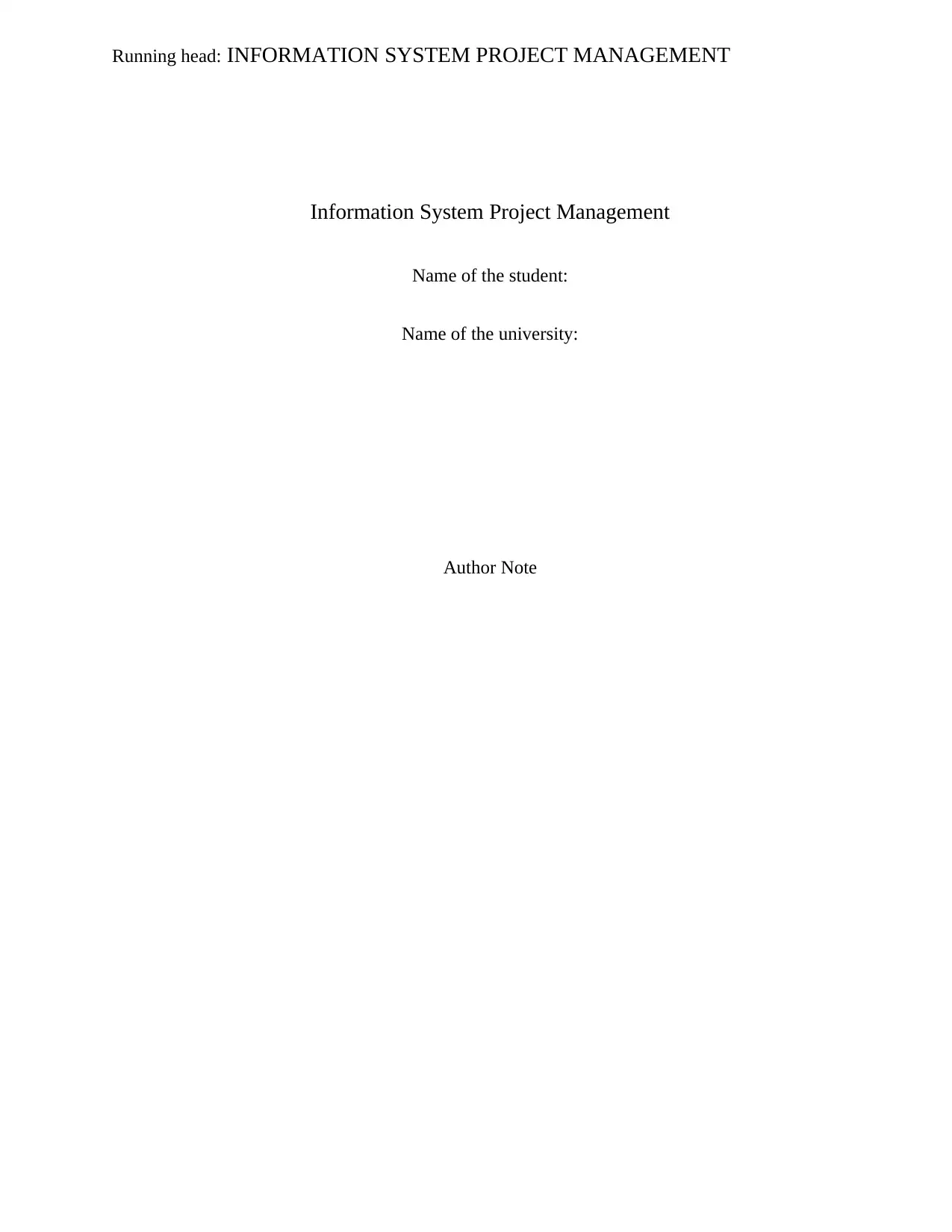
Running head: INFORMATION SYSTEM PROJECT MANAGEMENT
Information System Project Management
Name of the student:
Name of the university:
Author Note
Information System Project Management
Name of the student:
Name of the university:
Author Note
Paraphrase This Document
Need a fresh take? Get an instant paraphrase of this document with our AI Paraphraser
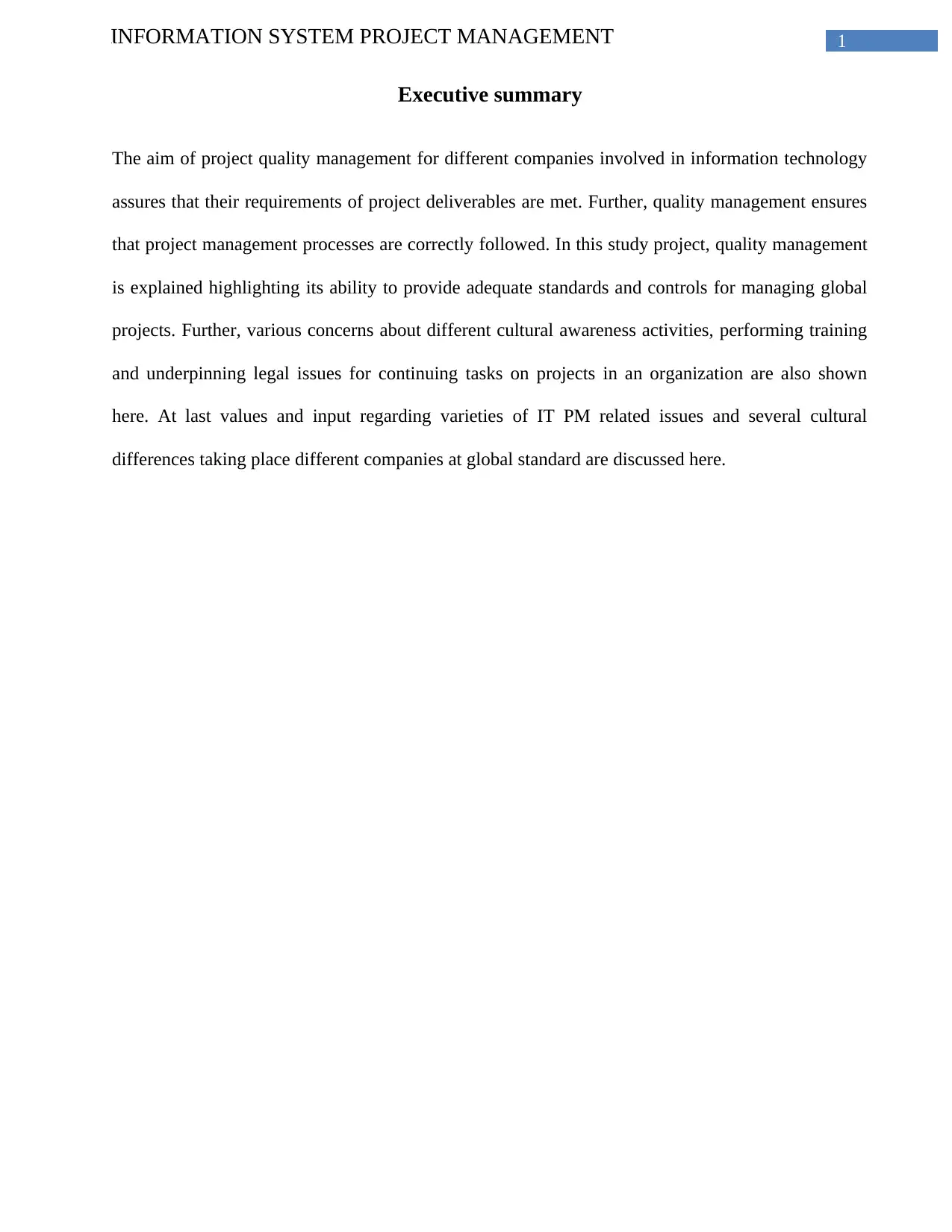
1INFORMATION SYSTEM PROJECT MANAGEMENT
Executive summary
The aim of project quality management for different companies involved in information technology
assures that their requirements of project deliverables are met. Further, quality management ensures
that project management processes are correctly followed. In this study project, quality management
is explained highlighting its ability to provide adequate standards and controls for managing global
projects. Further, various concerns about different cultural awareness activities, performing training
and underpinning legal issues for continuing tasks on projects in an organization are also shown
here. At last values and input regarding varieties of IT PM related issues and several cultural
differences taking place different companies at global standard are discussed here.
Executive summary
The aim of project quality management for different companies involved in information technology
assures that their requirements of project deliverables are met. Further, quality management ensures
that project management processes are correctly followed. In this study project, quality management
is explained highlighting its ability to provide adequate standards and controls for managing global
projects. Further, various concerns about different cultural awareness activities, performing training
and underpinning legal issues for continuing tasks on projects in an organization are also shown
here. At last values and input regarding varieties of IT PM related issues and several cultural
differences taking place different companies at global standard are discussed here.
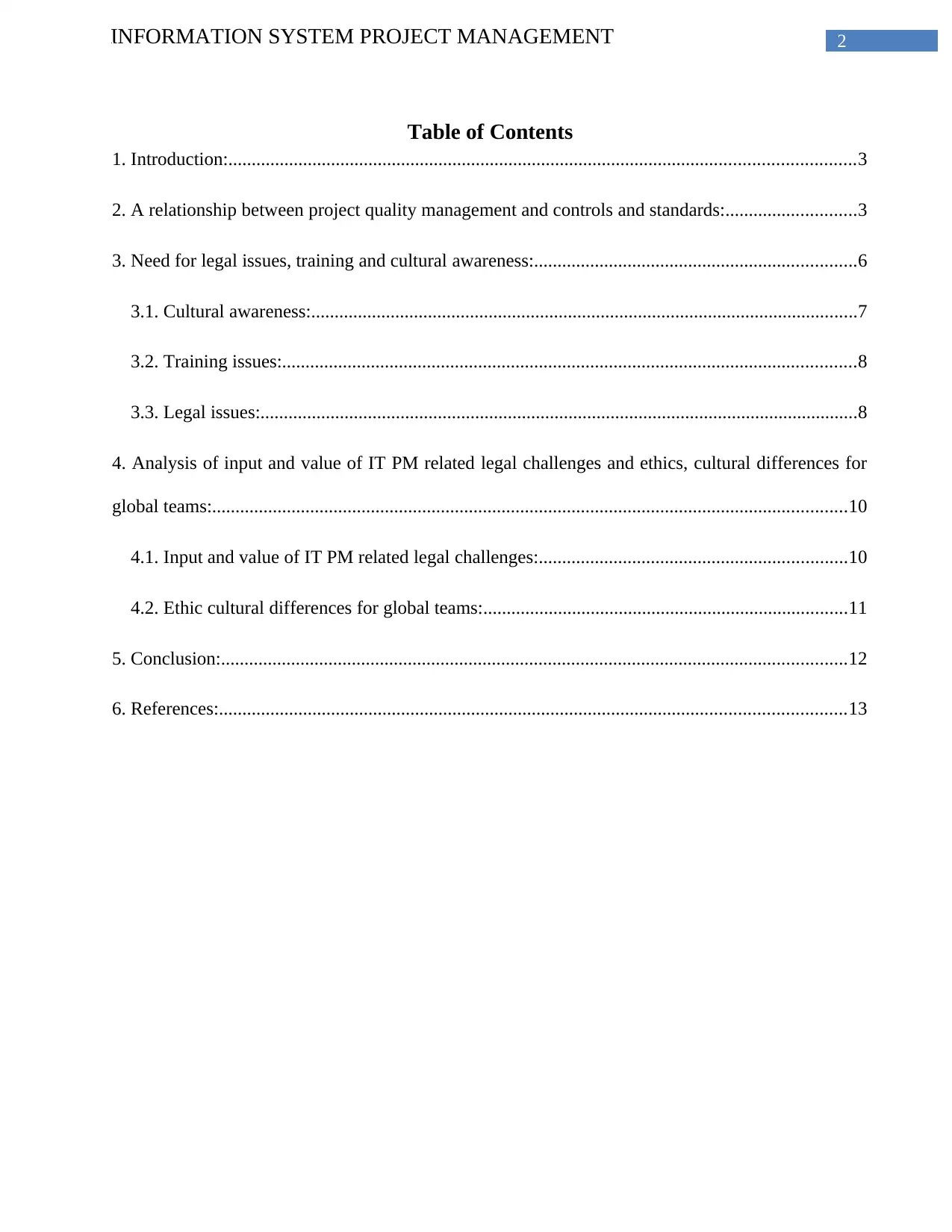
2INFORMATION SYSTEM PROJECT MANAGEMENT
Table of Contents
1. Introduction:......................................................................................................................................3
2. A relationship between project quality management and controls and standards:............................3
3. Need for legal issues, training and cultural awareness:.....................................................................6
3.1. Cultural awareness:.....................................................................................................................7
3.2. Training issues:...........................................................................................................................8
3.3. Legal issues:................................................................................................................................8
4. Analysis of input and value of IT PM related legal challenges and ethics, cultural differences for
global teams:........................................................................................................................................10
4.1. Input and value of IT PM related legal challenges:..................................................................10
4.2. Ethic cultural differences for global teams:..............................................................................11
5. Conclusion:......................................................................................................................................12
6. References:......................................................................................................................................13
Table of Contents
1. Introduction:......................................................................................................................................3
2. A relationship between project quality management and controls and standards:............................3
3. Need for legal issues, training and cultural awareness:.....................................................................6
3.1. Cultural awareness:.....................................................................................................................7
3.2. Training issues:...........................................................................................................................8
3.3. Legal issues:................................................................................................................................8
4. Analysis of input and value of IT PM related legal challenges and ethics, cultural differences for
global teams:........................................................................................................................................10
4.1. Input and value of IT PM related legal challenges:..................................................................10
4.2. Ethic cultural differences for global teams:..............................................................................11
5. Conclusion:......................................................................................................................................12
6. References:......................................................................................................................................13
⊘ This is a preview!⊘
Do you want full access?
Subscribe today to unlock all pages.

Trusted by 1+ million students worldwide
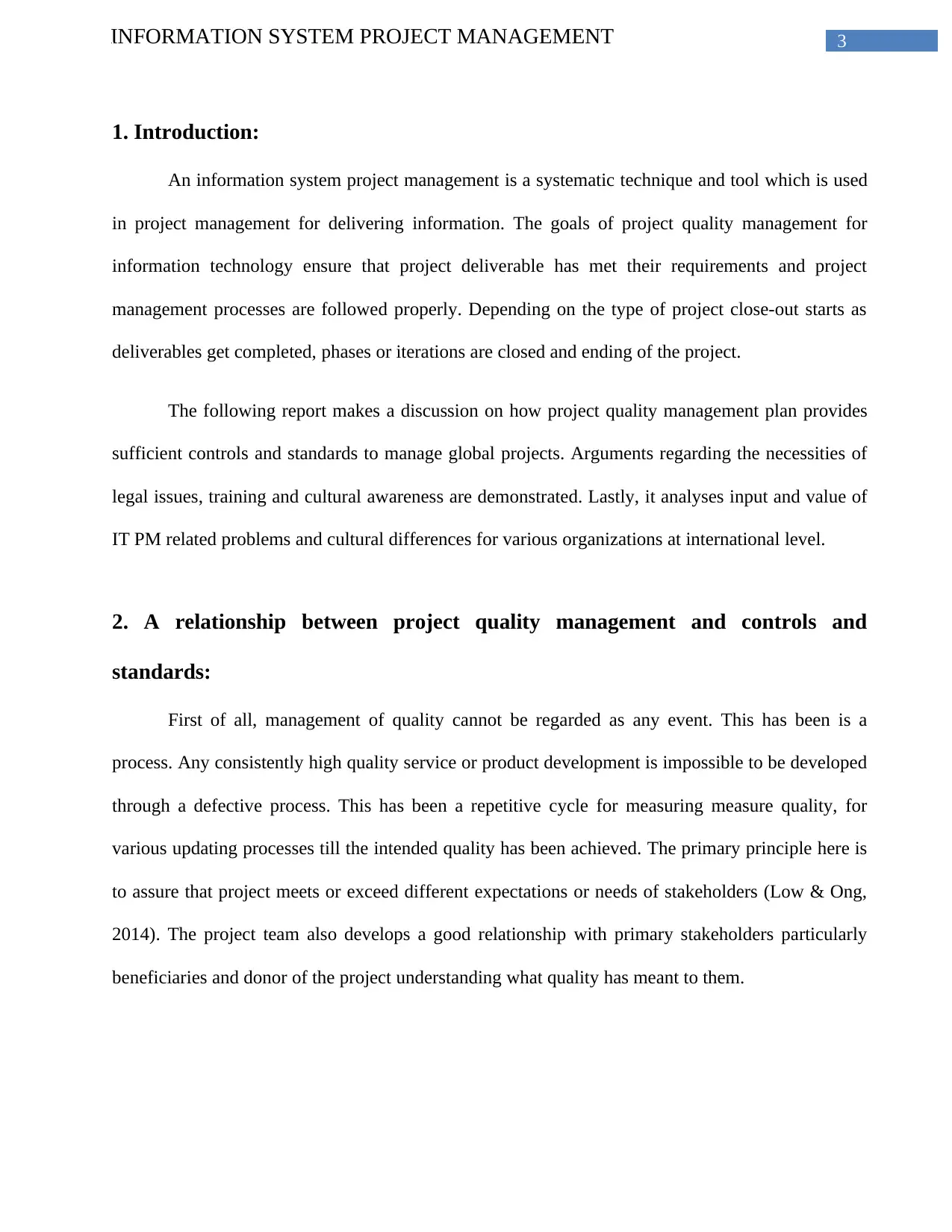
3INFORMATION SYSTEM PROJECT MANAGEMENT
1. Introduction:
An information system project management is a systematic technique and tool which is used
in project management for delivering information. The goals of project quality management for
information technology ensure that project deliverable has met their requirements and project
management processes are followed properly. Depending on the type of project close-out starts as
deliverables get completed, phases or iterations are closed and ending of the project.
The following report makes a discussion on how project quality management plan provides
sufficient controls and standards to manage global projects. Arguments regarding the necessities of
legal issues, training and cultural awareness are demonstrated. Lastly, it analyses input and value of
IT PM related problems and cultural differences for various organizations at international level.
2. A relationship between project quality management and controls and
standards:
First of all, management of quality cannot be regarded as any event. This has been is a
process. Any consistently high quality service or product development is impossible to be developed
through a defective process. This has been a repetitive cycle for measuring measure quality, for
various updating processes till the intended quality has been achieved. The primary principle here is
to assure that project meets or exceed different expectations or needs of stakeholders (Low & Ong,
2014). The project team also develops a good relationship with primary stakeholders particularly
beneficiaries and donor of the project understanding what quality has meant to them.
1. Introduction:
An information system project management is a systematic technique and tool which is used
in project management for delivering information. The goals of project quality management for
information technology ensure that project deliverable has met their requirements and project
management processes are followed properly. Depending on the type of project close-out starts as
deliverables get completed, phases or iterations are closed and ending of the project.
The following report makes a discussion on how project quality management plan provides
sufficient controls and standards to manage global projects. Arguments regarding the necessities of
legal issues, training and cultural awareness are demonstrated. Lastly, it analyses input and value of
IT PM related problems and cultural differences for various organizations at international level.
2. A relationship between project quality management and controls and
standards:
First of all, management of quality cannot be regarded as any event. This has been is a
process. Any consistently high quality service or product development is impossible to be developed
through a defective process. This has been a repetitive cycle for measuring measure quality, for
various updating processes till the intended quality has been achieved. The primary principle here is
to assure that project meets or exceed different expectations or needs of stakeholders (Low & Ong,
2014). The project team also develops a good relationship with primary stakeholders particularly
beneficiaries and donor of the project understanding what quality has meant to them.
Paraphrase This Document
Need a fresh take? Get an instant paraphrase of this document with our AI Paraphraser
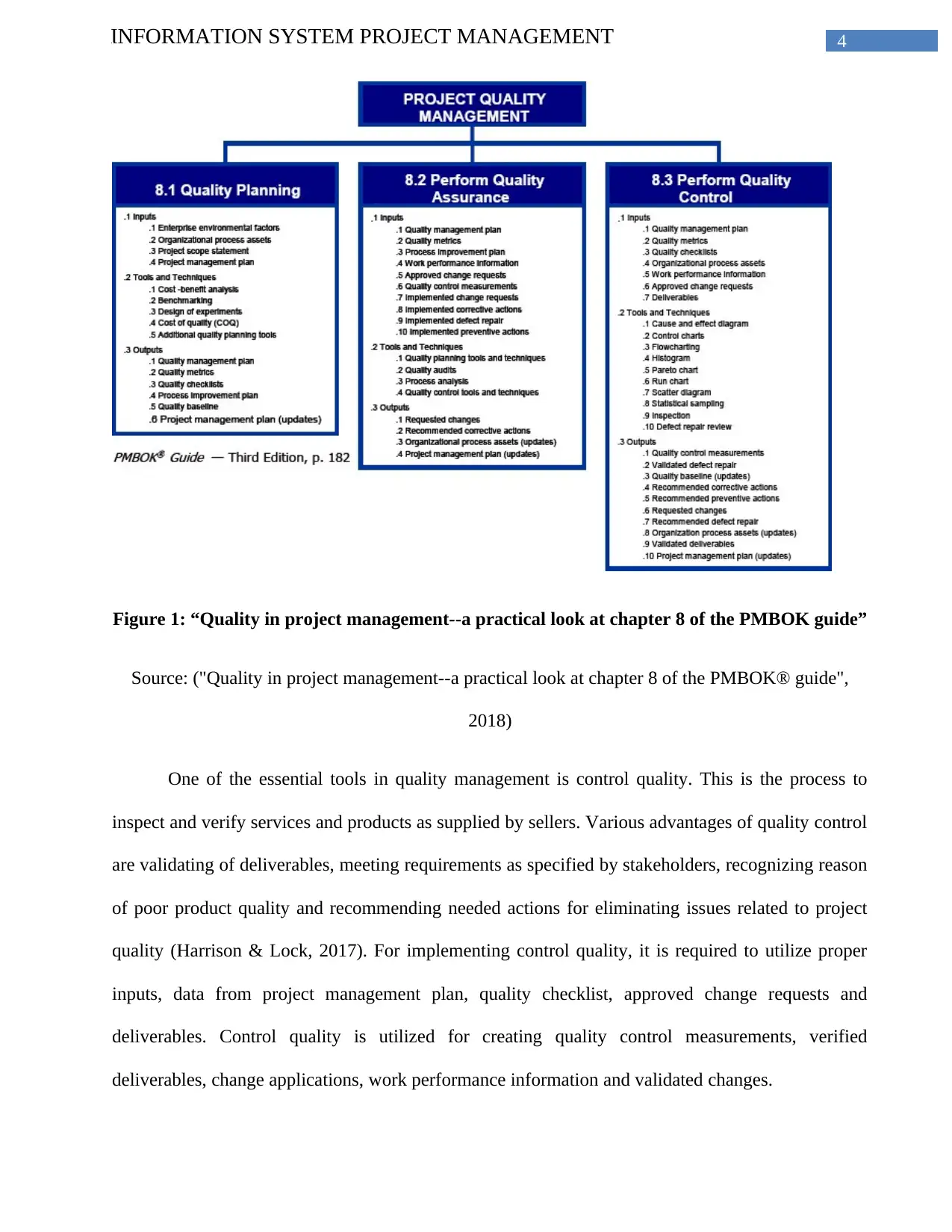
4INFORMATION SYSTEM PROJECT MANAGEMENT
Figure 1: “Quality in project management--a practical look at chapter 8 of the PMBOK guide”
Source: ("Quality in project management--a practical look at chapter 8 of the PMBOK® guide",
2018)
One of the essential tools in quality management is control quality. This is the process to
inspect and verify services and products as supplied by sellers. Various advantages of quality control
are validating of deliverables, meeting requirements as specified by stakeholders, recognizing reason
of poor product quality and recommending needed actions for eliminating issues related to project
quality (Harrison & Lock, 2017). For implementing control quality, it is required to utilize proper
inputs, data from project management plan, quality checklist, approved change requests and
deliverables. Control quality is utilized for creating quality control measurements, verified
deliverables, change applications, work performance information and validated changes.
Figure 1: “Quality in project management--a practical look at chapter 8 of the PMBOK guide”
Source: ("Quality in project management--a practical look at chapter 8 of the PMBOK® guide",
2018)
One of the essential tools in quality management is control quality. This is the process to
inspect and verify services and products as supplied by sellers. Various advantages of quality control
are validating of deliverables, meeting requirements as specified by stakeholders, recognizing reason
of poor product quality and recommending needed actions for eliminating issues related to project
quality (Harrison & Lock, 2017). For implementing control quality, it is required to utilize proper
inputs, data from project management plan, quality checklist, approved change requests and
deliverables. Control quality is utilized for creating quality control measurements, verified
deliverables, change applications, work performance information and validated changes.
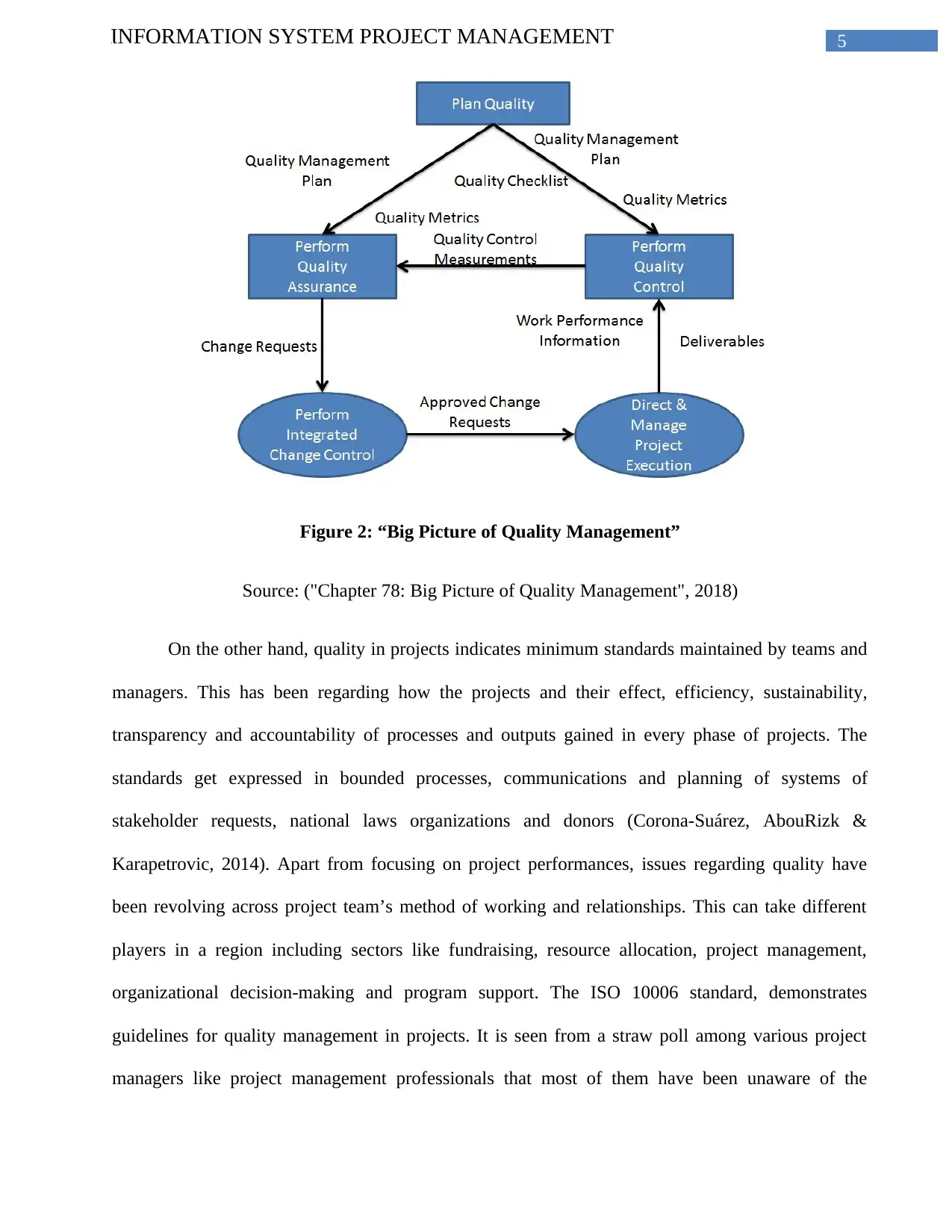
5INFORMATION SYSTEM PROJECT MANAGEMENT
Figure 2: “Big Picture of Quality Management”
Source: ("Chapter 78: Big Picture of Quality Management", 2018)
On the other hand, quality in projects indicates minimum standards maintained by teams and
managers. This has been regarding how the projects and their effect, efficiency, sustainability,
transparency and accountability of processes and outputs gained in every phase of projects. The
standards get expressed in bounded processes, communications and planning of systems of
stakeholder requests, national laws organizations and donors (Corona-Suárez, AbouRizk &
Karapetrovic, 2014). Apart from focusing on project performances, issues regarding quality have
been revolving across project team’s method of working and relationships. This can take different
players in a region including sectors like fundraising, resource allocation, project management,
organizational decision-making and program support. The ISO 10006 standard, demonstrates
guidelines for quality management in projects. It is seen from a straw poll among various project
managers like project management professionals that most of them have been unaware of the
Figure 2: “Big Picture of Quality Management”
Source: ("Chapter 78: Big Picture of Quality Management", 2018)
On the other hand, quality in projects indicates minimum standards maintained by teams and
managers. This has been regarding how the projects and their effect, efficiency, sustainability,
transparency and accountability of processes and outputs gained in every phase of projects. The
standards get expressed in bounded processes, communications and planning of systems of
stakeholder requests, national laws organizations and donors (Corona-Suárez, AbouRizk &
Karapetrovic, 2014). Apart from focusing on project performances, issues regarding quality have
been revolving across project team’s method of working and relationships. This can take different
players in a region including sectors like fundraising, resource allocation, project management,
organizational decision-making and program support. The ISO 10006 standard, demonstrates
guidelines for quality management in projects. It is seen from a straw poll among various project
managers like project management professionals that most of them have been unaware of the
⊘ This is a preview!⊘
Do you want full access?
Subscribe today to unlock all pages.

Trusted by 1+ million students worldwide
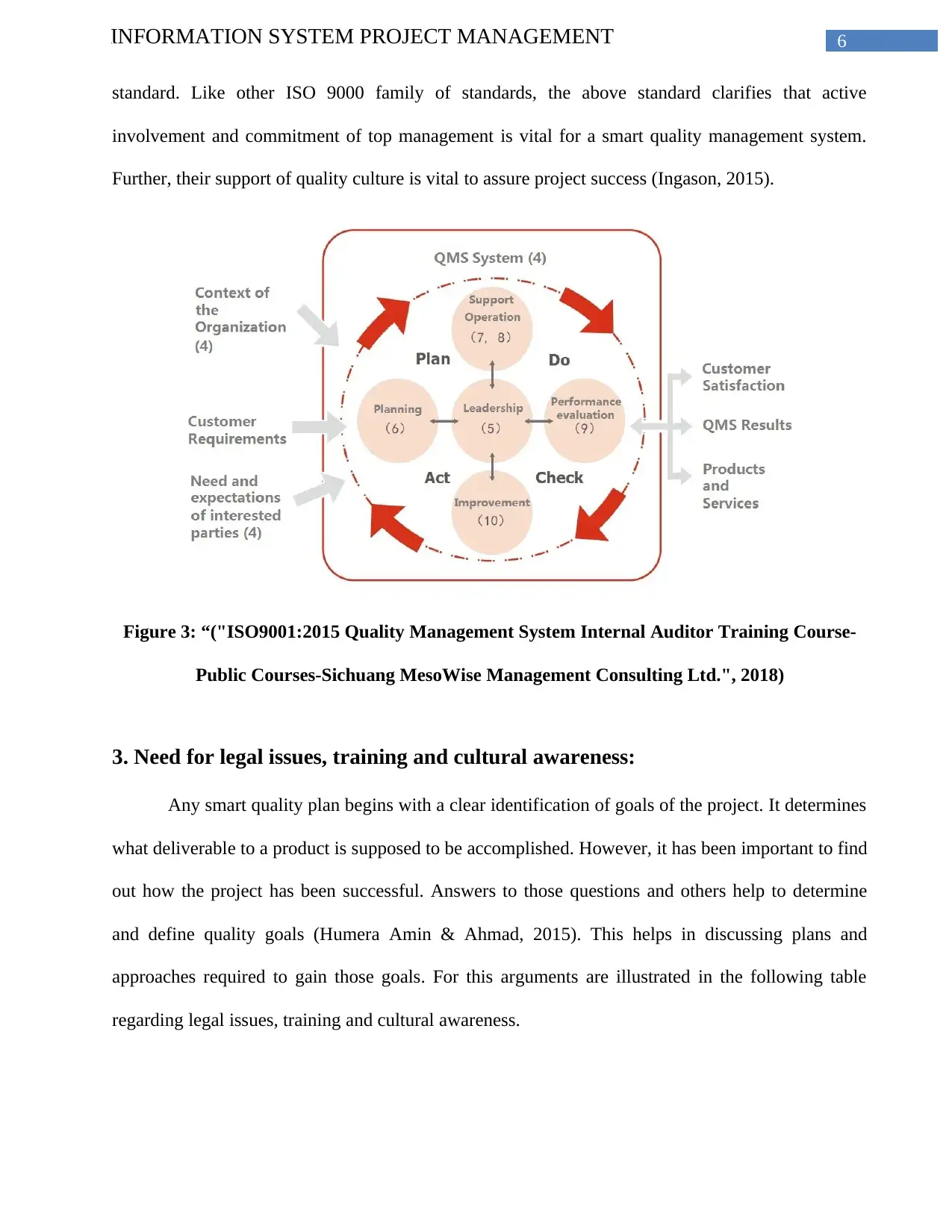
6INFORMATION SYSTEM PROJECT MANAGEMENT
standard. Like other ISO 9000 family of standards, the above standard clarifies that active
involvement and commitment of top management is vital for a smart quality management system.
Further, their support of quality culture is vital to assure project success (Ingason, 2015).
Figure 3: “("ISO9001:2015 Quality Management System Internal Auditor Training Course-
Public Courses-Sichuang MesoWise Management Consulting Ltd.", 2018)
3. Need for legal issues, training and cultural awareness:
Any smart quality plan begins with a clear identification of goals of the project. It determines
what deliverable to a product is supposed to be accomplished. However, it has been important to find
out how the project has been successful. Answers to those questions and others help to determine
and define quality goals (Humera Amin & Ahmad, 2015). This helps in discussing plans and
approaches required to gain those goals. For this arguments are illustrated in the following table
regarding legal issues, training and cultural awareness.
standard. Like other ISO 9000 family of standards, the above standard clarifies that active
involvement and commitment of top management is vital for a smart quality management system.
Further, their support of quality culture is vital to assure project success (Ingason, 2015).
Figure 3: “("ISO9001:2015 Quality Management System Internal Auditor Training Course-
Public Courses-Sichuang MesoWise Management Consulting Ltd.", 2018)
3. Need for legal issues, training and cultural awareness:
Any smart quality plan begins with a clear identification of goals of the project. It determines
what deliverable to a product is supposed to be accomplished. However, it has been important to find
out how the project has been successful. Answers to those questions and others help to determine
and define quality goals (Humera Amin & Ahmad, 2015). This helps in discussing plans and
approaches required to gain those goals. For this arguments are illustrated in the following table
regarding legal issues, training and cultural awareness.
Paraphrase This Document
Need a fresh take? Get an instant paraphrase of this document with our AI Paraphraser
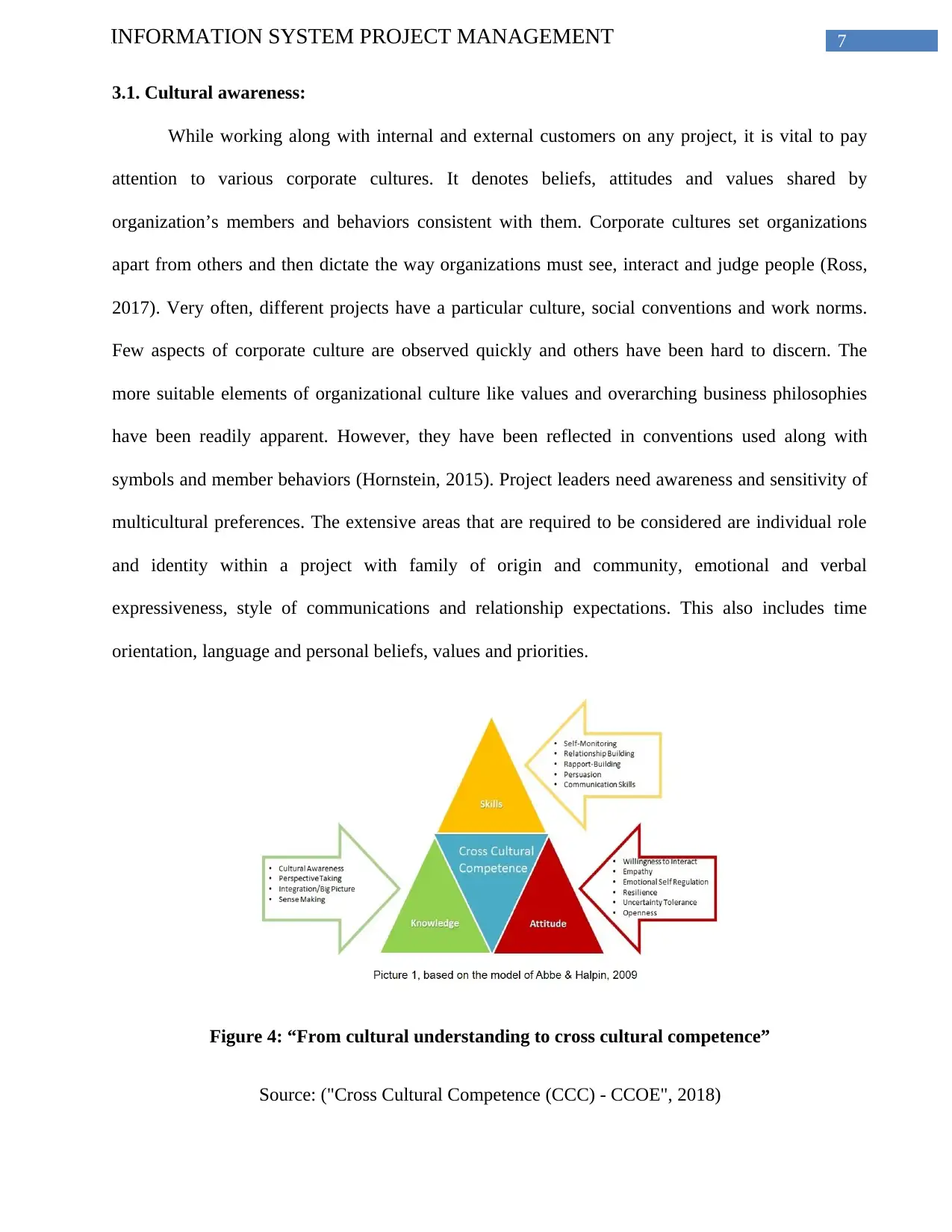
7INFORMATION SYSTEM PROJECT MANAGEMENT
3.1. Cultural awareness:
While working along with internal and external customers on any project, it is vital to pay
attention to various corporate cultures. It denotes beliefs, attitudes and values shared by
organization’s members and behaviors consistent with them. Corporate cultures set organizations
apart from others and then dictate the way organizations must see, interact and judge people (Ross,
2017). Very often, different projects have a particular culture, social conventions and work norms.
Few aspects of corporate culture are observed quickly and others have been hard to discern. The
more suitable elements of organizational culture like values and overarching business philosophies
have been readily apparent. However, they have been reflected in conventions used along with
symbols and member behaviors (Hornstein, 2015). Project leaders need awareness and sensitivity of
multicultural preferences. The extensive areas that are required to be considered are individual role
and identity within a project with family of origin and community, emotional and verbal
expressiveness, style of communications and relationship expectations. This also includes time
orientation, language and personal beliefs, values and priorities.
Figure 4: “From cultural understanding to cross cultural competence”
Source: ("Cross Cultural Competence (CCC) - CCOE", 2018)
3.1. Cultural awareness:
While working along with internal and external customers on any project, it is vital to pay
attention to various corporate cultures. It denotes beliefs, attitudes and values shared by
organization’s members and behaviors consistent with them. Corporate cultures set organizations
apart from others and then dictate the way organizations must see, interact and judge people (Ross,
2017). Very often, different projects have a particular culture, social conventions and work norms.
Few aspects of corporate culture are observed quickly and others have been hard to discern. The
more suitable elements of organizational culture like values and overarching business philosophies
have been readily apparent. However, they have been reflected in conventions used along with
symbols and member behaviors (Hornstein, 2015). Project leaders need awareness and sensitivity of
multicultural preferences. The extensive areas that are required to be considered are individual role
and identity within a project with family of origin and community, emotional and verbal
expressiveness, style of communications and relationship expectations. This also includes time
orientation, language and personal beliefs, values and priorities.
Figure 4: “From cultural understanding to cross cultural competence”
Source: ("Cross Cultural Competence (CCC) - CCOE", 2018)
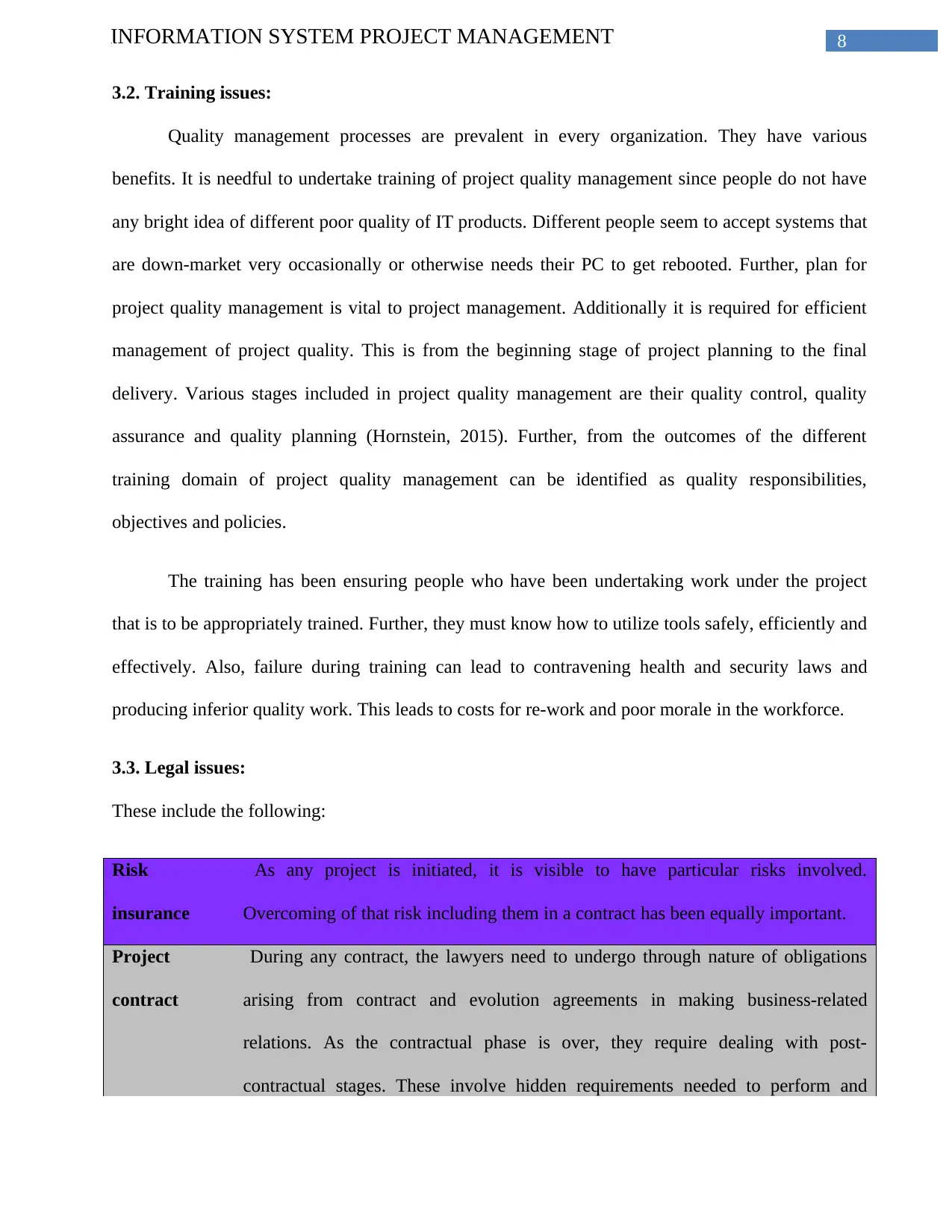
8INFORMATION SYSTEM PROJECT MANAGEMENT
3.2. Training issues:
Quality management processes are prevalent in every organization. They have various
benefits. It is needful to undertake training of project quality management since people do not have
any bright idea of different poor quality of IT products. Different people seem to accept systems that
are down-market very occasionally or otherwise needs their PC to get rebooted. Further, plan for
project quality management is vital to project management. Additionally it is required for efficient
management of project quality. This is from the beginning stage of project planning to the final
delivery. Various stages included in project quality management are their quality control, quality
assurance and quality planning (Hornstein, 2015). Further, from the outcomes of the different
training domain of project quality management can be identified as quality responsibilities,
objectives and policies.
The training has been ensuring people who have been undertaking work under the project
that is to be appropriately trained. Further, they must know how to utilize tools safely, efficiently and
effectively. Also, failure during training can lead to contravening health and security laws and
producing inferior quality work. This leads to costs for re-work and poor morale in the workforce.
3.3. Legal issues:
These include the following:
Risk
insurance
As any project is initiated, it is visible to have particular risks involved.
Overcoming of that risk including them in a contract has been equally important.
Project
contract
During any contract, the lawyers need to undergo through nature of obligations
arising from contract and evolution agreements in making business-related
relations. As the contractual phase is over, they require dealing with post-
contractual stages. These involve hidden requirements needed to perform and
3.2. Training issues:
Quality management processes are prevalent in every organization. They have various
benefits. It is needful to undertake training of project quality management since people do not have
any bright idea of different poor quality of IT products. Different people seem to accept systems that
are down-market very occasionally or otherwise needs their PC to get rebooted. Further, plan for
project quality management is vital to project management. Additionally it is required for efficient
management of project quality. This is from the beginning stage of project planning to the final
delivery. Various stages included in project quality management are their quality control, quality
assurance and quality planning (Hornstein, 2015). Further, from the outcomes of the different
training domain of project quality management can be identified as quality responsibilities,
objectives and policies.
The training has been ensuring people who have been undertaking work under the project
that is to be appropriately trained. Further, they must know how to utilize tools safely, efficiently and
effectively. Also, failure during training can lead to contravening health and security laws and
producing inferior quality work. This leads to costs for re-work and poor morale in the workforce.
3.3. Legal issues:
These include the following:
Risk
insurance
As any project is initiated, it is visible to have particular risks involved.
Overcoming of that risk including them in a contract has been equally important.
Project
contract
During any contract, the lawyers need to undergo through nature of obligations
arising from contract and evolution agreements in making business-related
relations. As the contractual phase is over, they require dealing with post-
contractual stages. These involve hidden requirements needed to perform and
⊘ This is a preview!⊘
Do you want full access?
Subscribe today to unlock all pages.

Trusted by 1+ million students worldwide
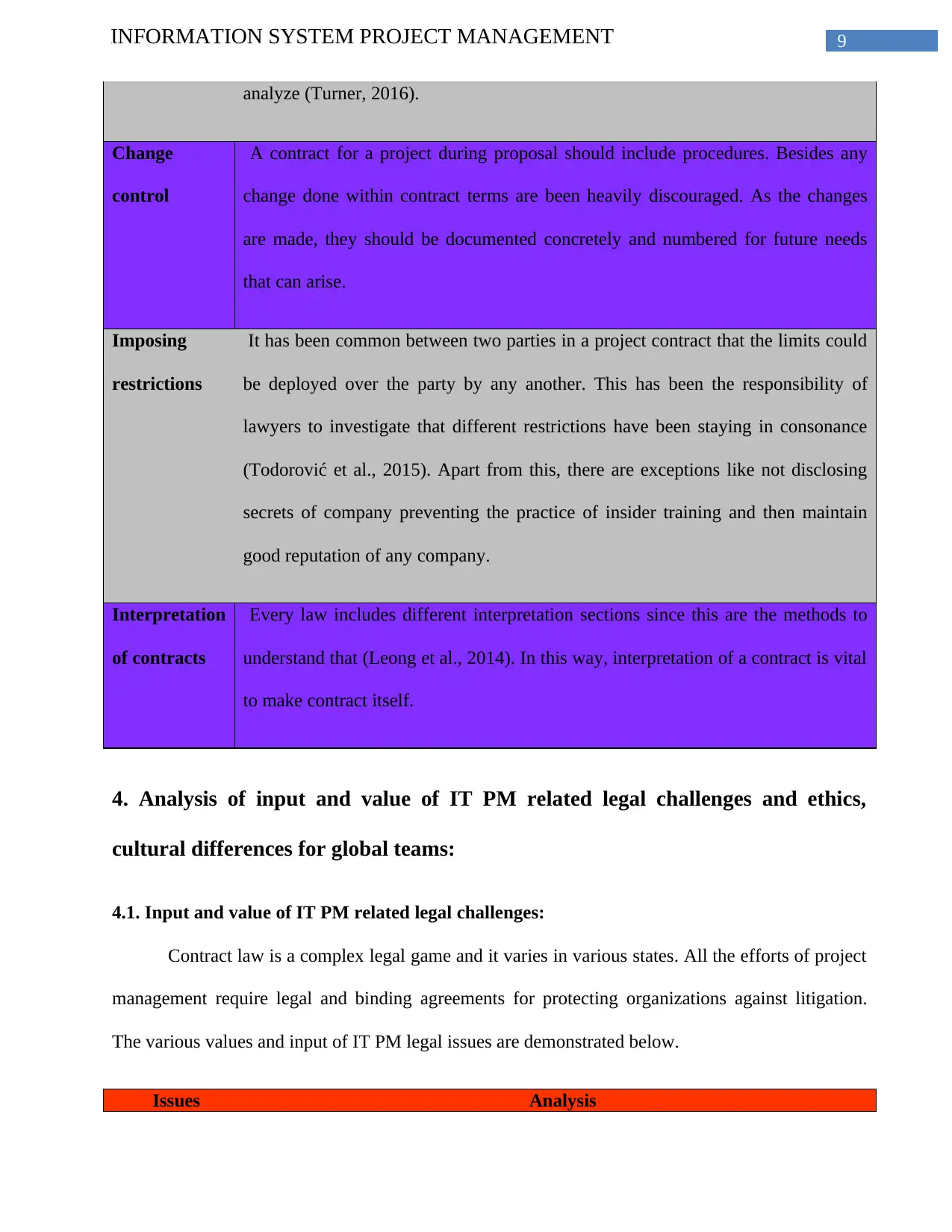
9INFORMATION SYSTEM PROJECT MANAGEMENT
analyze (Turner, 2016).
Change
control
A contract for a project during proposal should include procedures. Besides any
change done within contract terms are been heavily discouraged. As the changes
are made, they should be documented concretely and numbered for future needs
that can arise.
Imposing
restrictions
It has been common between two parties in a project contract that the limits could
be deployed over the party by any another. This has been the responsibility of
lawyers to investigate that different restrictions have been staying in consonance
(Todorović et al., 2015). Apart from this, there are exceptions like not disclosing
secrets of company preventing the practice of insider training and then maintain
good reputation of any company.
Interpretation
of contracts
Every law includes different interpretation sections since this are the methods to
understand that (Leong et al., 2014). In this way, interpretation of a contract is vital
to make contract itself.
4. Analysis of input and value of IT PM related legal challenges and ethics,
cultural differences for global teams:
4.1. Input and value of IT PM related legal challenges:
Contract law is a complex legal game and it varies in various states. All the efforts of project
management require legal and binding agreements for protecting organizations against litigation.
The various values and input of IT PM legal issues are demonstrated below.
Issues Analysis
analyze (Turner, 2016).
Change
control
A contract for a project during proposal should include procedures. Besides any
change done within contract terms are been heavily discouraged. As the changes
are made, they should be documented concretely and numbered for future needs
that can arise.
Imposing
restrictions
It has been common between two parties in a project contract that the limits could
be deployed over the party by any another. This has been the responsibility of
lawyers to investigate that different restrictions have been staying in consonance
(Todorović et al., 2015). Apart from this, there are exceptions like not disclosing
secrets of company preventing the practice of insider training and then maintain
good reputation of any company.
Interpretation
of contracts
Every law includes different interpretation sections since this are the methods to
understand that (Leong et al., 2014). In this way, interpretation of a contract is vital
to make contract itself.
4. Analysis of input and value of IT PM related legal challenges and ethics,
cultural differences for global teams:
4.1. Input and value of IT PM related legal challenges:
Contract law is a complex legal game and it varies in various states. All the efforts of project
management require legal and binding agreements for protecting organizations against litigation.
The various values and input of IT PM legal issues are demonstrated below.
Issues Analysis
Paraphrase This Document
Need a fresh take? Get an instant paraphrase of this document with our AI Paraphraser
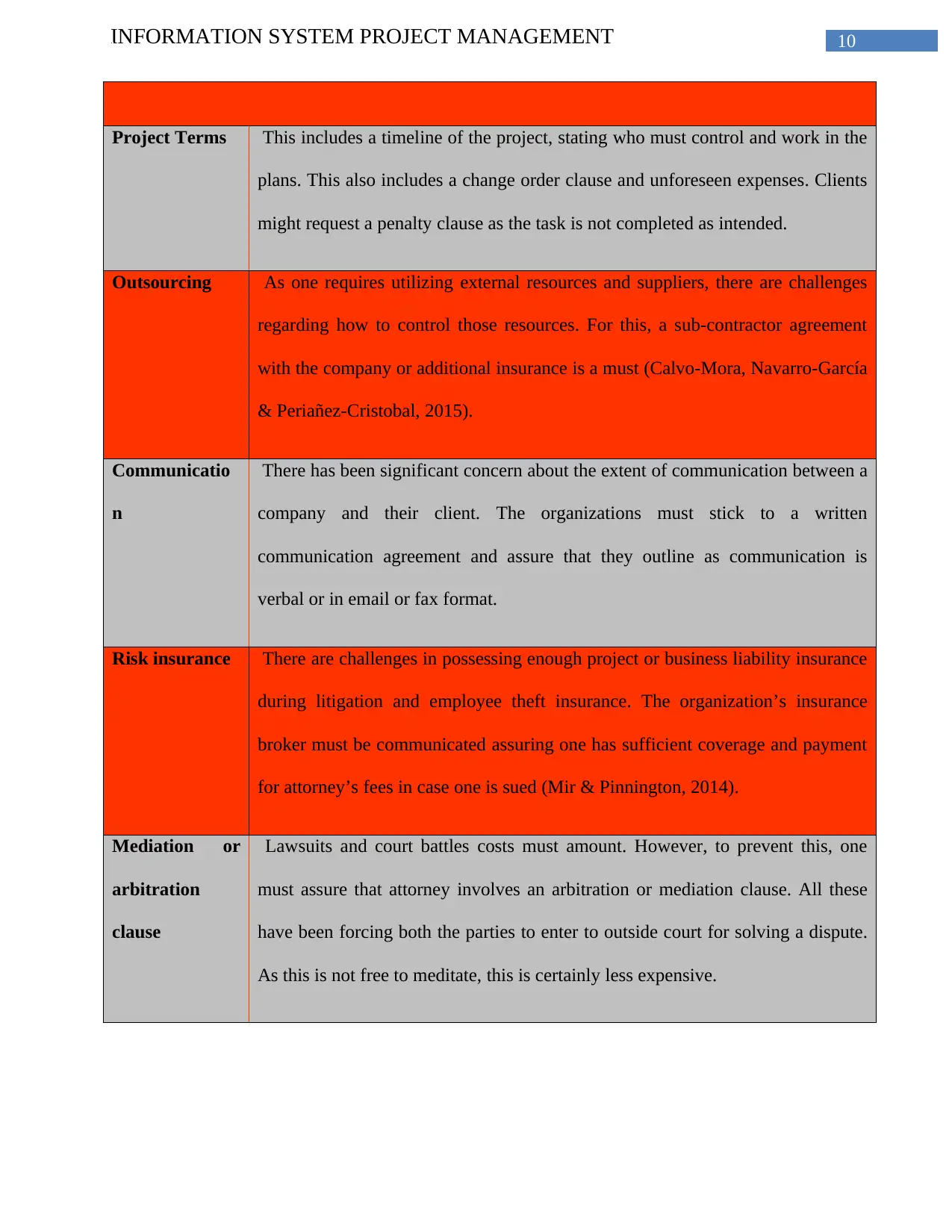
10INFORMATION SYSTEM PROJECT MANAGEMENT
Project Terms This includes a timeline of the project, stating who must control and work in the
plans. This also includes a change order clause and unforeseen expenses. Clients
might request a penalty clause as the task is not completed as intended.
Outsourcing As one requires utilizing external resources and suppliers, there are challenges
regarding how to control those resources. For this, a sub-contractor agreement
with the company or additional insurance is a must (Calvo-Mora, Navarro-García
& Periañez-Cristobal, 2015).
Communicatio
n
There has been significant concern about the extent of communication between a
company and their client. The organizations must stick to a written
communication agreement and assure that they outline as communication is
verbal or in email or fax format.
Risk insurance There are challenges in possessing enough project or business liability insurance
during litigation and employee theft insurance. The organization’s insurance
broker must be communicated assuring one has sufficient coverage and payment
for attorney’s fees in case one is sued (Mir & Pinnington, 2014).
Mediation or
arbitration
clause
Lawsuits and court battles costs must amount. However, to prevent this, one
must assure that attorney involves an arbitration or mediation clause. All these
have been forcing both the parties to enter to outside court for solving a dispute.
As this is not free to meditate, this is certainly less expensive.
Project Terms This includes a timeline of the project, stating who must control and work in the
plans. This also includes a change order clause and unforeseen expenses. Clients
might request a penalty clause as the task is not completed as intended.
Outsourcing As one requires utilizing external resources and suppliers, there are challenges
regarding how to control those resources. For this, a sub-contractor agreement
with the company or additional insurance is a must (Calvo-Mora, Navarro-García
& Periañez-Cristobal, 2015).
Communicatio
n
There has been significant concern about the extent of communication between a
company and their client. The organizations must stick to a written
communication agreement and assure that they outline as communication is
verbal or in email or fax format.
Risk insurance There are challenges in possessing enough project or business liability insurance
during litigation and employee theft insurance. The organization’s insurance
broker must be communicated assuring one has sufficient coverage and payment
for attorney’s fees in case one is sued (Mir & Pinnington, 2014).
Mediation or
arbitration
clause
Lawsuits and court battles costs must amount. However, to prevent this, one
must assure that attorney involves an arbitration or mediation clause. All these
have been forcing both the parties to enter to outside court for solving a dispute.
As this is not free to meditate, this is certainly less expensive.
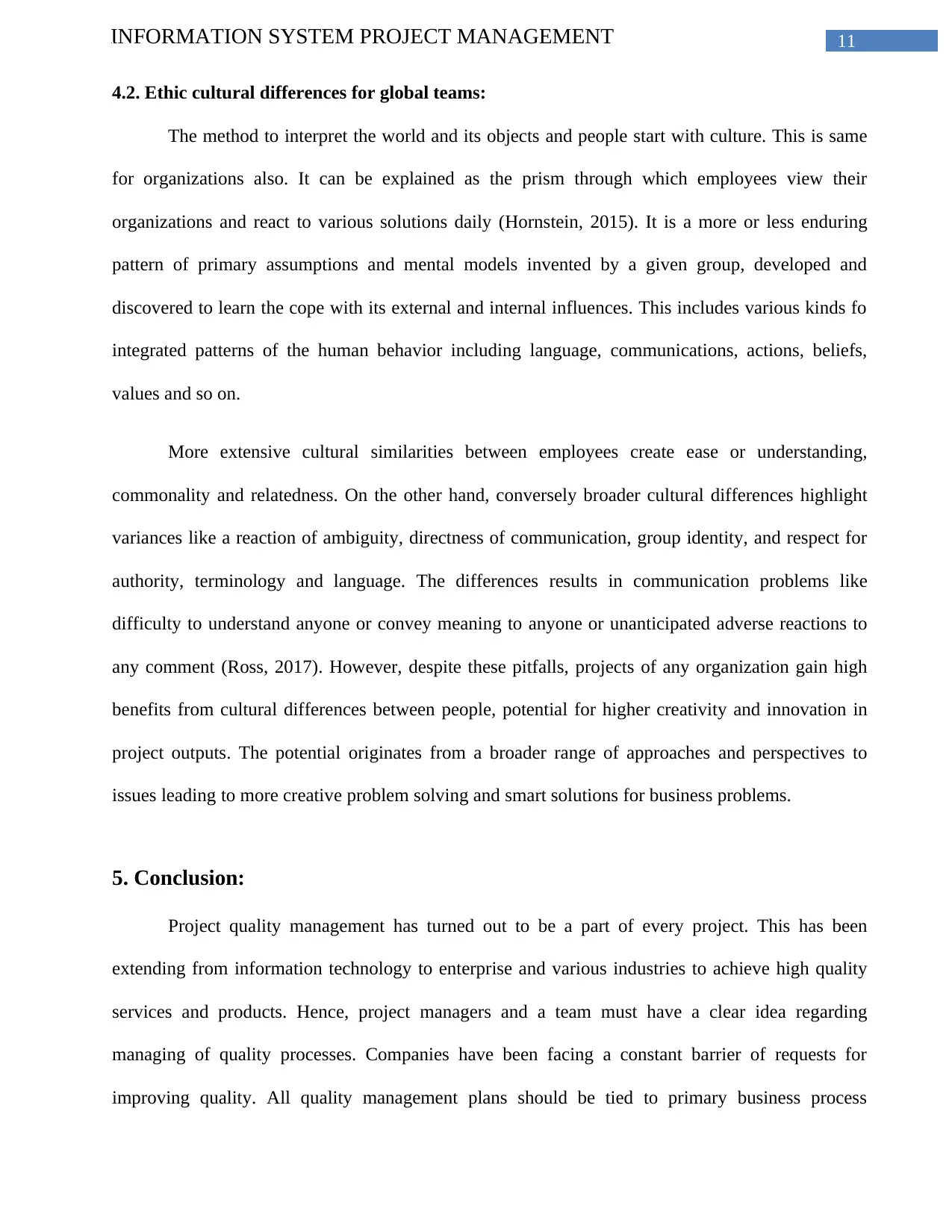
11INFORMATION SYSTEM PROJECT MANAGEMENT
4.2. Ethic cultural differences for global teams:
The method to interpret the world and its objects and people start with culture. This is same
for organizations also. It can be explained as the prism through which employees view their
organizations and react to various solutions daily (Hornstein, 2015). It is a more or less enduring
pattern of primary assumptions and mental models invented by a given group, developed and
discovered to learn the cope with its external and internal influences. This includes various kinds fo
integrated patterns of the human behavior including language, communications, actions, beliefs,
values and so on.
More extensive cultural similarities between employees create ease or understanding,
commonality and relatedness. On the other hand, conversely broader cultural differences highlight
variances like a reaction of ambiguity, directness of communication, group identity, and respect for
authority, terminology and language. The differences results in communication problems like
difficulty to understand anyone or convey meaning to anyone or unanticipated adverse reactions to
any comment (Ross, 2017). However, despite these pitfalls, projects of any organization gain high
benefits from cultural differences between people, potential for higher creativity and innovation in
project outputs. The potential originates from a broader range of approaches and perspectives to
issues leading to more creative problem solving and smart solutions for business problems.
5. Conclusion:
Project quality management has turned out to be a part of every project. This has been
extending from information technology to enterprise and various industries to achieve high quality
services and products. Hence, project managers and a team must have a clear idea regarding
managing of quality processes. Companies have been facing a constant barrier of requests for
improving quality. All quality management plans should be tied to primary business process
4.2. Ethic cultural differences for global teams:
The method to interpret the world and its objects and people start with culture. This is same
for organizations also. It can be explained as the prism through which employees view their
organizations and react to various solutions daily (Hornstein, 2015). It is a more or less enduring
pattern of primary assumptions and mental models invented by a given group, developed and
discovered to learn the cope with its external and internal influences. This includes various kinds fo
integrated patterns of the human behavior including language, communications, actions, beliefs,
values and so on.
More extensive cultural similarities between employees create ease or understanding,
commonality and relatedness. On the other hand, conversely broader cultural differences highlight
variances like a reaction of ambiguity, directness of communication, group identity, and respect for
authority, terminology and language. The differences results in communication problems like
difficulty to understand anyone or convey meaning to anyone or unanticipated adverse reactions to
any comment (Ross, 2017). However, despite these pitfalls, projects of any organization gain high
benefits from cultural differences between people, potential for higher creativity and innovation in
project outputs. The potential originates from a broader range of approaches and perspectives to
issues leading to more creative problem solving and smart solutions for business problems.
5. Conclusion:
Project quality management has turned out to be a part of every project. This has been
extending from information technology to enterprise and various industries to achieve high quality
services and products. Hence, project managers and a team must have a clear idea regarding
managing of quality processes. Companies have been facing a constant barrier of requests for
improving quality. All quality management plans should be tied to primary business process
⊘ This is a preview!⊘
Do you want full access?
Subscribe today to unlock all pages.

Trusted by 1+ million students worldwide
1 out of 14
Related Documents
Your All-in-One AI-Powered Toolkit for Academic Success.
+13062052269
info@desklib.com
Available 24*7 on WhatsApp / Email
![[object Object]](/_next/static/media/star-bottom.7253800d.svg)
Unlock your academic potential
Copyright © 2020–2025 A2Z Services. All Rights Reserved. Developed and managed by ZUCOL.




